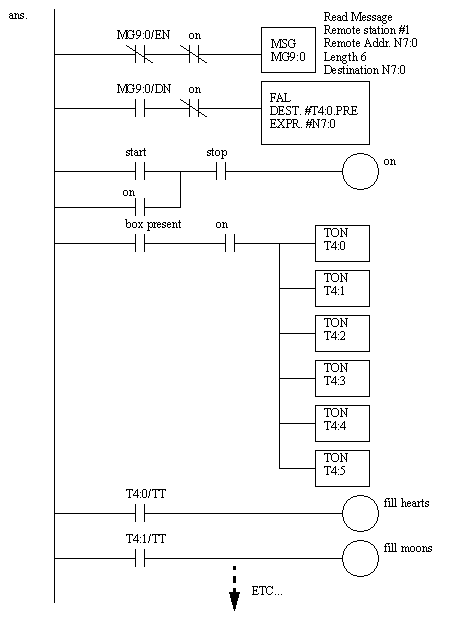1.9 PRACTICE PROBLEMS
1. Explain why networks are important in manufacturing controls.
ans. These networks allow us to pass data between devices so that individually controlled systems can be integrated into a more complex manufacturing facility. An example might be a serial connection to a PLC so that SPC data can be collected as product is made, or recipes downloaded as they are needed.
2. We will use a PLC to control a cereal box filling machine. For single runs the quantities of cereal types are controlled using timers. There are 6 different timers that control flow, and these result in different ratios of product. The values for the timer presets will be downloaded from another PLC using the DH+ network. Write the ladder logic for the PLC.

3. a) We are developing ladder logic for an oven to be used in a baking facility. A PLC is controlling the temperature of an oven using an analog voltage output. The oven must be started with a push button and can be stopped at any time with a stop push button. A recipe is used to control the times at each temperature (this is written into the PLC memory by another PLC). When idle, the output voltage should be 0V, and during heating the output voltages, in sequence, are 5V, 7.5V, 9V. The timer preset values, in sequence, are in N7:0, N7:1, N7:2. When the oven is on, a value of 1 should be stored in N7:3, and when the oven is off, a value of 0 should be stored in N7:3. Draw a state diagram and write the ladder logic for this station.
b) We are using a PLC as a master controller in a baking facility. It will update recipes in remote PLCs using DH+. The master station is #1, the remote stations are #2 and #3. When an operator pushes one of three buttons, it will change the recipes in two remote PLCs if both of the remote PLCs are idle. While the remote PLCs are running they will change words in their internal memories (N7:3=0 means idle and N7:3=1 means active). The new recipe values will be written to the remote PLCs using DH+. The table below shows the values for each PLC. Write the ladder logic for the master controller.
4. Describe what the bits would be when an ‘A’ (ASCII 65) is transmitted in an RS-232 interface with 8 data bits, even parity and 1 stop bit.
5.